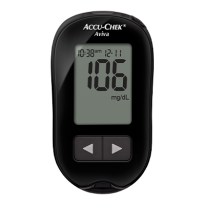User Manuals

The Accu-Chek Aviva blood glucose meter makes testing your blood sugar quick and easy. It’s ready to use right out of the box, requiring no set-up. Each meter uses Accu-Chek Aviva test strips and an Accu-Chek lancing device. Helpful alerts remind you to test before and after meals, giving you valuable information to support therapy decisions for a healthy active life.
Product ManualsUnique serial number printed on a label on the device and stored in non-volatile memory
Mutant variant of quinoprotein glucose dehydrogenase (Mut. Q-GDH), electrochemical
Approximately 5 seconds
Temperature: 8°C to 44°C (46°F to 111°F)
-25°C to + 70°C (-13°F to +158°F)
Up to 500 total results, plus 20 control tests
7, 14, 30 and 90 days
Infrared (IR)
Get accurate results in 3 steps: